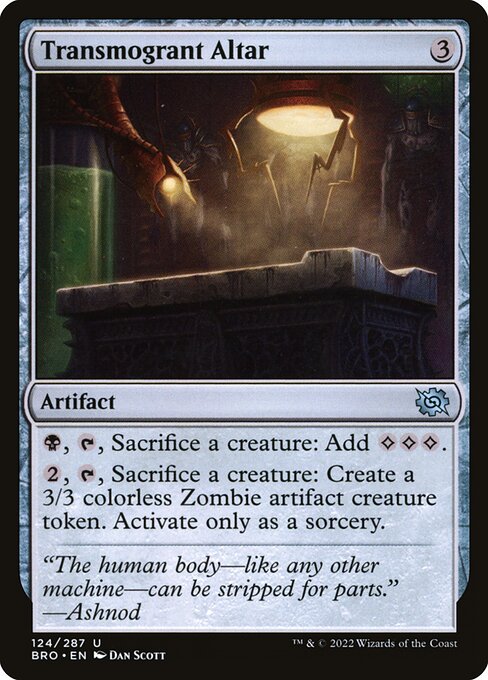
Image courtesy of Scryfall.com
Hidden Details in The Brothers’ War: Transmogrant Altar
There’s a quiet thrill that comes from studying MTG card art beyond its immediate function on the battlefield. Transmogrant Altar, a brooding artifact from The Brothers’ War, rewards close inspection with a cascade of micro-narratives and mechanical puns tucked into the frame. At first glance, the piece is a stark biomechanical altar—the kind of ominous workstation Ashnod would approve of—yet the more you look, the more you notice how the illustration uses space, texture, and implied motion to propel the card’s themes of sacrifice, transformation, and power. 🧙♂️🔥
Dan Murayama Scott’s artistry leans into a chiaroscuro of metal and sinew, with rivets that become teeth and gears that double as eyelids. The altar itself acts as a vessel for a dark alchemy: a creature is sacrificed to fuel colorless mana, a transaction that sits at the heart of the card’s ability wheel. The hidden details aren’t just about horror aesthetics; they mirror the card’s mechanical logic. In MTG, every line of text has a rhythm, and the illustration choreographs a companion dance between what you pay and what you gain—an echo of the old-cycle mindset that “the body serves the machine,” a sentiment echoed in the flavor text attributed to Ashnod. The human body—like any other machine—can be stripped for parts. — Ashnod
Transmogrant Altar is an artifact with a black color identity, a rare pairing that signals a darker take on mana engine strategies. Its mana cost is modest—just three—and its potential impact scales with the sacrifices you can muster. The first activation, B, T, Sacrifice a creature: Add {C}{C}{C}, creates a slippery ramp that can power a wealth of colorless plays in the late game. The design invites a deck that leans into sacrifice outlets, token generation, and synergy with other colorless or artifact-centric strategies. In the looming tempo of a match, that trio of colorless mana can feel like a cheat code, sidestepping traditional color ramps and putting you on a literal fast track to colossal plays. 💎⚔️
The secondary ability—2, T, Sacrifice a creature: Create a 3/3 colorless Zombie artifact creature token—turns your sacrifice into a tangible board advantage. The token is not just “another body”; it’s a payload that can feed your other synergies or become fodder for the altar itself. Because activation is sorcery-speed, timing matters: you’re investing in tempo and protection for the next turn, rather than forcing a last-minute burst. This restriction fits perfectly with The Brothers’ War’s narrative tension, where every ritual is a calculated risk in a world where power is forged through careful, sometimes brutal, manipulation of parts and pieces. 🧭
In terms of lore, Transmogrant Altar nods to Ashnod’s mechanized philosophy and to the broader intrigue of the Brothers’ War—where artificers and necromancers push the boundaries between life and machine. The flavor text anchors the card in a specific frame of reference: a world where parts are plundered, repurposed, and reassembled into engines of victory. For players who savor story-rich cards, the art and text work in harmony to tell a tale of ruthless innovation, where the altar’s gleaming surface reflects not just mana but the glint of ambition and the shadows of consequences. 🧙♂️🎨
From a gameplay perspective, Transmogrant Altar excels in settings that appreciate sacrifice as a resource, rather than a cost to be minimized. The token generation helps fill board presence while feeding the altar’s own mana engine. It’s a card that rewards planning: you set up a sequence where each sacrifice enriches your mana and, eventually, your board state with a resilient 3/3 zombie artifact creature. The card’s rarity as an uncommon underscores its role as a flavorful, niche enabler rather than a mainstream power house, a characteristic that collectors often savor in The Brothers’ War artifacts. Its artwork and flavor are a reminder that the strongest engines often hide in plain sight, waiting for you to read between the gears. 🔧💎
Collectors who enjoy the intersection of art and play may also notice the subtle balance of color and tone in the piece. The absence of color in the art’s identity itself mirrors the colorless mana created by the altar’s use, even as the card pays with a black mana cost. It’s a quiet wink to the “colorless matters” themes that have threaded through artifact-heavy designs across MTG history. If you’re an admirer of MTG lore, you’ll appreciate how this card quietly integrates Ashnod’s philosophical through-line with a practical, modern-styled engine. And for those of us who keep a desk while we draft, the combination of sleek black frame and chrome-like art texture is as much a visual treat as a tactical resource. 🎲🧭
The Brothers’ War itself is a battlefield of competing ideologies and tools; Transmogrant Altar captures a microcosm of that story—an altar that cannily converts sacrifice into power, a ritual that can turn the tide with careful timing. The card’s illustration invites fans to pause, zoom in, and spot the little touches that give it depth—the way the lighting catches on the altar’s edge, the way the token’s form hints at its future, or the way the background hints at a lab where parts are weighed and measured. It’s a compelling reminder that MTG art isn’t just pretty packaging; it’s a storytelling engine that invites you to imagine the moment just before the spell resolves. ⚔️🎨
And if you’re hunting for a way to celebrate these vibes in the real world, consider how a subtle tabletop setup can echo the theme. A desk mat or mouse pad with a clean, tactile surface—like the PU Leather Mouse Pad with Non-Slip Backing—helps your game space feel as curated as a card’s lore. It’s a small detail, but in a hobby built on layers of detail, every piece matters. PU Leather Mouse Pad with Non-Slip Backing 🧙♂️
More from our network
- https://blog.digital-vault.xyz/blog/post/maximize-black-friday-with-irresistible-digital-art-bundles/
- https://blog.digital-vault.xyz/blog/post/red-color-reveals-dwarfs-versus-giants-at-2-kpc/
- https://transparent-paper.shop/blog/post/designing-printable-vision-boards-for-daily-inspiration/
- https://crypto-acolytes.xyz/blog/post/decoding-discord-pump-schemes-behind-meme-coins/
- https://blog.digital-vault.xyz/blog/post/modeling-mtg-deck-outcomes-with-cactus-preserve/